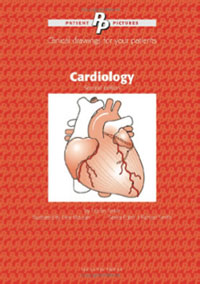Since the advent of online self-diagnosis sites, such as www.diagnose-me.com, and online doctors (www.netdoctor.co.uk), the increase of knowledgeable patients has been noticeable in GP’s surgeries and specialists alike, with patients often arriving with an expectancy of something being wrong rather than the hope of all being well. To combat this, carefully written and well-presented patient literature – in both online and traditional print matter – has increased massively.

Author: Forfar C
Publisher: Health Press Limited,
Abingdon, 2009
ISBN: 978-1-903734-04-9
Price £10.00
Much current literature is poorly written and suffers from low patient recall due to the heavy repetition of technical words (Health Communication 1994;6:327–35). Patient pictures: cardiology is one of a new breed of patient literature directed with images at the forefront. Other examples include the comic series targeted at children, Medikidz, which recently received a BMJ write up and Joe’s Guide to Diabetes, which made its way into The Times.
Using an article from the Student BMJ archive on how to write effective patient literature (http://archive.student.bmj.com/issues/05/05/careers/200.php), I rated the book using their paramaters. The article asks: “What is the most appropriate way to give the information?“ and Patient pictures: cardiology is laid out in precisely the right way. A bullet point structure removes any patronisation, while the use of adjacent clinical drawings and real world examples leads to a well-rounded understanding of what to expect and what will occur. Technical terminology is highlighted and explained immediately, helping the reader become accustomed to complex language.
A second question in the Student BMJ article asks: “What messages do medics want to convey?”. This text covers all the ground, from examining risk factors for coronary heart disease, or diagnostic tools such as radionuclide testing and angiograms, to treatment involving drugs, pacemakers or electrical intervention. One of the better sections is on cardioversion – the most instantly recognisable of treatments – and Patient pictures: cardiology carefully explains this with detailed pictures and bullet points as well as other choices.
Finally onto the first question: “What do patients want to know?”. This is where Patient pictures: cardiology really excels. The best information in the book I believe is the flow chart of ‘Hospital visits for heart diseases’, which breaks down exactly what a patient can expect from the doctors over the course of their treatment.
Overall, Patient pictures: cardiology is an excellent text, neatly packaged, providing excellent recall (as tested on myself!). The mission statement of the Patient pictures series is: “to advance the practice of medicine by providing clear, understandable, relevant information both to healthcare professionals and the public”. This book is geared towards the public rather than healthcare professionals and would make a good addition to any waiting room.
